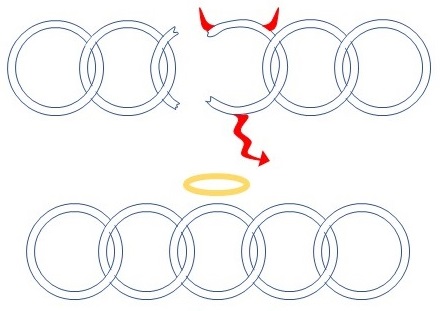A sad fact of human nature is that it’s easy to form and continue bad habits, while it’s tough to make and maintain good ones. Although this post is meant to help writers, the technique I present could help anyone with a habit problem.
An excellent post by Leo Babauta inspired me to build on his thoughts.
Perhaps you’d like to break a bad habit of using too many adverbs in your writing. Or maybe you’d like to form the good habit of incorporating all five senses into your descriptions. Whatever bad thing you want less of, or good thing you want more of, read on.
The Habit Chain
Since I last wrote about habits, I’ve refined my thinking. I now think of them as a process, a chain with links. Habits start out as deliberate routine actions. You have to consciously think about them the first few times. They usually are triggered by something else, and I’ll call that a cue. The cue occurs, you perform the routine action, and get a reward. The reward generally satisfies some need you have. (In the case of good habits, you usually have to provide the reward yourself.)
Eventually, whenever the cue occurs, you feel a strong urge to perform the routine so you can get the reward. With enough repetition of this process, you start performing the action unconsciously, right after the cue, and you earn the reward right away. That routine action has now become a habit. The shorter the time between cue and action, and action and reward, the stronger the links are and the more ingrained the habit will be.
Obviously, the idea is to break your bad habit chains and forge good habit chains.
Breaking or Forging Habit Chains
- State Your Reason. This method takes some effort, so identify why you want to tackle this particular habit. Later, when the going gets tough, it will be useful to remind yourself why you set off on the journey.
- Commit to the Effort. This isn’t an ‘oh, well, I’ll give it a try’ kind of thing. This is heart and soul time. This is not the hen’s involvement with your breakfast; it’s the pig’s total commitment. You didn’t form the bad habit overnight, and you won’t forge the good one quickly either; this will take time.
- Obtain Support and be Accountable. Seek an ‘accountability partner’ who will periodically ask for progress updates and to whom you’ll report. Schedule regular meetings with your partner to keep on track.
- Identify your Cues. Find the event that triggers your bad habit. Or, to forge a good habit, pick an event that will trigger you to perform that good habit.
- Work on the Cue-Action Link.
- For bad habits, pause when the cue occurs. Try to resist the urge to perform the habit. Also, think about alternate, or replacement actions you could take to satisfy the need, and work on performing those instead of the ingrained habit action.
- For good habits, perform the desired action as soon after the cue as possible. Whenever the cue occurs, work on making the routine action as automatic as possible.
- Work on the Action-Reward Link.
- For bad habits, think about why you crave the reward. What need is it satisfying? Are there other ways to satisfy it? If it’s possible to deny yourself the reward, try that and see what happens.
- For good habits, reward yourself promptly after completing the action. Tightening that link will help ingrain the habit.
- Remind Yourself. Bad habits become so automatic that they follow the cue by reflex action. Good habits need to follow immediately after their cue. Therefore, you need visual reminders of your habit-breaking or habit-forging effort placed around where the cues occur.
- Permit No Exceptions. You’ll never break that bad habit or adopt that new one if you give yourself an out. The moment you backslide and make excuses for that, you’re well on the road to abandoning the effort.
- Don’t Beat Yourself Up. Okay, the ‘no exceptions’ rule didn’t work and you messed up. The cue occurred and you went back to your bad habit or failed to perform the good habit. Rather than giving up, or getting a self-defeating attitude, look back at Step 1 and remind yourself of the important reason you started taking these steps. Then, learn from the backsliding episode. Analyze what happened and why. Alter your approach. Consider new ways to break a bad habit chain or reinforce a good habit chain. Focus on the cue and realize there’s a moment of decision between it and the habit, an opportunity for you to change.
- Stay Positive. Maintain an upbeat and confident attitude about this habit-changing process. You can do it. You’re not doomed to repeat your past mistakes. You have the capacity to change for the better and you can make those changes work for you. Of course it will be difficult, but few worthwhile things are easy.
There you have it. Good luck! Remember, some habits are okay and require no change, like my habit of signing all my blogposts as—
Poseidon’s Scribe



 We live in a distraction-rich environment. Even before the Internet, there were rooms to clean, library books to return, lawns to mow, desk items to straighten, and windows to gaze through. Today, there are Facebook posts to like, tweets to retweet, texts to answer, online stores to shop in, blog posts to read, and new sites to explore.
We live in a distraction-rich environment. Even before the Internet, there were rooms to clean, library books to return, lawns to mow, desk items to straighten, and windows to gaze through. Today, there are Facebook posts to like, tweets to retweet, texts to answer, online stores to shop in, blog posts to read, and new sites to explore.